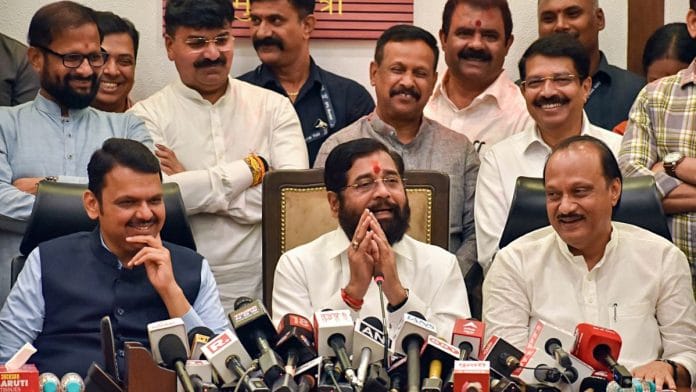Mumbai: The ruling Mahayuti on Saturday swept the Maharashtra election, the first assembly polls in the state after the redrawing of traditional alliances following splits of two major regional parties. As of 8 pm, the Mahayuti alliance was reaching a tally of 231 seats in the 288-member house.
The halfway mark for the Maharashtra assembly is 144.
The MVA includes the Congress, the Shiv Sena (Uddhav Balasaheb Thackeray) and the NCP (Sharadchandra Pawar). As of 8 pm, the Congress was winning 15 seats, the Shiv Sena (UBT) on 20 seats, and the Sharad Pawar-led NCP on 10 seats.
Speaking to reporters, Shiv Sena (UBT) Chief Uddhav Thackeray showed his disbelief at the verdict. He said, “After looking at inflation, agrarian distress, the anger of women towards the establishment, we did not expect this verdict. There was a lot of crowd at our rallies too. On the other hand we were seeing empty chairs at Modi and Shah’s rallies.”
In major upsets for the MVA, Congress’ Balasaheb Thorat lost his stronghold of Sangamner to the Shinde-led SHiv Sena’s Amol Khatal, and former Congress CM Prithviraj CHavan lost his seat of Karad South to BJP’s Atulbaba Bhosale. Maharashtra COngress Chief Nana Patole was trailing in his constituency by a slim margin of 658 votes against the BJP’s Avinash Brahmankar.
In the Sharad Pawar-led NCP, the party lost the Pawar family bastion of Baramati to incumbent Ajit Pawar.
Speaking to reporters, Deputy CM Ajit Pawar said, “In all my years in politics I have never seen Maharashtra give such a decisive mandate to any coalition. This is a historic tally for Mahayuti.”
The Mahayuti’s campaign hinged on its flagship Ladki Bahin scheme, rolled out in the state budget in July this year after the Lok Sabha election. Under the Ladki Bahin scheme, all eligible women between the ages of 21 and 65 with an annual family income of less than Rs 2.5 lakh receive Rs 1,500/month. If elected to power again, the Mahayuti has promised to raise this amount to Rs 2,100 a year.
The MVA, in its manifesto, announced a similar scheme, under which it promises to give Rs 3,000 per month.
Other than campaigning on Ladki Bahin and other development initiatives of the Shinde-led Mahayuti government, the ruling alliance also took on the MVA’s Lok Sabha election campaign’s focus on the Modi government intending to change the Constitution as a “fake narrative.”
Separately, the BJP attempted to consolidate the Hindutva vote by talking about how Muslims indulged in “vote jihad” during the Lok Sabha poll, pointing to how Muslims consolidated and voted against the BJP.
The MVA’s campaign, on the other hand, touched on various issues such as agrarian distress among cotton and soybean farmers in the state particularly, unemployment, the alleged flight of jobs and investment to Gujarat, and alleged incentives given to the Adani Group, especially as part of the Dharavi redevelopment project.
Lok Sabha results gave MVA an edge
In the Lok Sabha result earlier this year, the MVA had emerged as the stronger of the two alliances, winning 30 of Maharashtra’s 48 parliamentary seats. The Mahayuti won 17. One seat went to an Independent—a Congress rebel who later aligned himself with the MVA.
During the Lok Sabha election, leaders from both sides accepted that there was greater coordination among the MVA partners, who were able to transfer their votes to each other more effectively.
Sangli, the seat where the Independent candidate, Vishal Patil, won was the one seat where the Congress and the Shiv Sena (UBT) had a major disagreement. The Shiv Sena (UBT) announced its candidate for the seat amid the fallout. Disgruntled local Congress workers supported Vishal Patil more than the MVA’s official candidate, Chandrahar Patil.
Within the Mahayuti, on the other hand, seat-sharing discussions dragged on until just a handful of days were left before polling, leading to a delay in naming candidates and less time to campaign.
In the run-up to the assembly election, while there was dissent and internal rebellion on both sides, the bickering within the MVA especially came out in the open, with the alliance looking a little less coordinated than during the Lok Sabha poll.
The MVA was formed in 2019 when the undivided Shiv Sena splintered its alliance with the BJP after the assembly poll and joined hands with its ideological and political rivals, the Congress and the undivided NCP, to form a government under Uddhav Thackeray’s leadership.
In 2022, the Shiv Sena vertically split when Eknath Shinde walked out with a majority of MLAs, claiming to be the real Shiv Sena and joining hands with the BJP. According to the Shinde faction, it was a natural alliance, unlike the MVA.
The alliance of the Shinde-led Shiv Sena and the BJP formed a government in Maharashtra in June 2022 with Shinde as CM.
The NCP also suffered a split in July 2023 when Ajit Pawar walked out of the party with a majority of MLAs, claiming to be the real NCP and joining hands with the ruling side to form the three-party Mahayuti.
(Edited by Madhurita Goswami)
Also Read: In Maharashtra, Sangh Parivar seeks votes for Hindutva with ‘vote jihad’ warnings, sant sammelans






